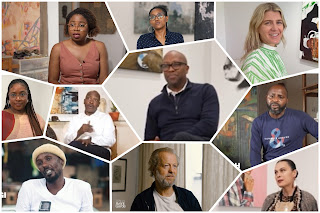In the latest episode of Africa Avant Garde, CNN dives into the two-way relationship between art and philanthropy in Africa, seeing how one benefits the other.
The art patron, Hakeem Adedeji, explains why art philanthropy is important, “Art is a multi-billion-dollar business, but you'll find that development of the artists in their raw form actually is a tiny part of that art ecosystem of the economics of that market. People need to come in to enable artists to develop their work without being too commercial. People need to come in and mentor those artists. Other professionals must be hired in order to support the artists.”
Adedeji moved into philanthropy, founding Red Heritage, “An art support institution that seeks to enable artists to move from their practices into the exhibition space. We also support art, other art professionals who are seeking to develop careers within the industry,” he says.
The artist Akanimoh Umoh says the support of Red Heritage in allowing him to have his first solo exhibition was “immense.” He continues, “It gave me art supplies, and covered the entire cost of the exhibition itself. And, I mean, I couldn't want for anything better than this.”
Umoh expands on his relationship with Red Heritage, saying, “The most beautiful thing about this symbiotic relationship I had with Red Heritage was that I was allowed, you know, artistic and creative freedom to be the artist that I needed to be.”
Adedeji is also the founder of Kobomoje Artist Residency, established in an old family house in Ibadan. He explains, “We established Kobomoje, the residency as a research based multidisciplinary residency. So all forms of art, all sort of manner of artists are invited to carry out their whatever research project they want to carry out.”
The visual artist and painter Nengi Omuku, who works on a vintage textile called Sanyan, and whose painting are inspired by current events in Nigeria, both political and personal, talks about the support of the residency, “I knew I wanted to research this textile a little bit more. I wanted to visit the market and beyond the market, I wanted to see where Sanyan was made traditionally. And those were things that were supported by the residency. I was there for five months. I ended up preparing for a solo show in that space.”
Adedeji sums up why he commits to this form of philanthropy, “The joy in the eyes of an artist whom you have just supported to hold an exhibition. The joy in the eyes of the audience is enough to compensate you for all pain that has gone into organising that. Honestly, if the work that we're doing can serve the purpose of attracting other people into that support ecosystem, I'm okay. My initial aim is how do we raise our sense of history and pride.”
Amref Health Africa, one of the oldest and largest African-based NGOs, is another example of how art can be a vehicle of philanthropy.
Dr. Githinji Gitahi, Amref’s CEO, says, “Amref is a health organisation working with governments communities to ensure that we can deliver primary healthcare to the most vulnerable. The way we do that is to distil the needs of the people and to present those through communication and through events like the art ball where we bring in the experiences of the African people on their behalf because it's really them who will present themselves.”
The director of development and communications at Amref Health Africa in the US, Emily Correale, talks about how the idea to hold the annual ArtBall came about, “We then were talking about African art and contemporary African art and how that was really on the rise, we decided maybe we should have a fundraiser that auctioned off African art. We would have the event be open to not just our donors, but to everyday people on the street to artists, to gatherers, to people in fashion, in finance, in all of the arts.”
Two of the ArtBall’s curators, Cierra Britton and Natalie Kates-Ferri agree on the benefits of donating to artists, with Kates-Ferri stating, “When I'm reaching out to an artist to donate for a nonprofit, the first question I'll ask them before soliciting them to donate something for free is that you're supporting your ecosystem. You're supporting causes you believe in, and you're giving equity agency power and voice through something you created.”
“The Art Ball itself through ticket sales, through auctions of the art, has brought significant income that has helped us to advance our mission back in Africa. And beyond that, it's opened up a lot of doors to high-net-worth individuals who have become not only short-term or medium-term, but long-term partners of ours,” concludes Gitahi.
Philanthropist Robert Devereux believes, “It's tough being an artist anywhere, but it's particularly tough in a country where there's a certain amount of antagonism towards becoming a professional artist.” He says, “You need a diverse culture of funding, and one of those funding streams is philanthropy from trust or foundations or whatever.”
He talks about the African Arts Trust he founded in Kenya, “We particularly focus on and are enthusiastic about core funding. We don't have a specific set of things that we'll support. Ultimately, it's just to try and have a stronger ecosystem for the artists and more artists who are able to actually pursue their careers and actually earn a living from it.”
Finally, Lynnet Ngigi, African Arts Trust Manager, sums up the impact philanthropy has had, “Philanthropy has really supported visual artists in Kenya, especially in terms of giving funding for spaces to be able to exist.”
https://edition.cnn.com/style/specials/africa-avant-garde









